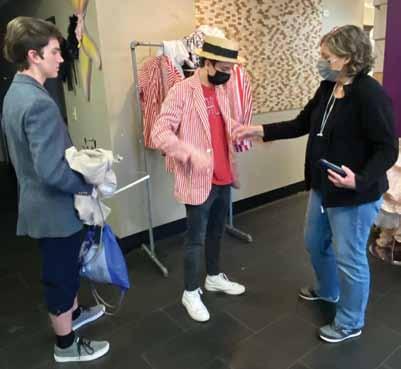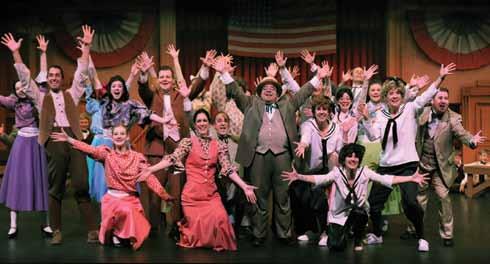
10 minute read
Association News
Order yOur heLp haLLOWeen happen SuppLieS
The NCA 2021 Help Halloween Happen campaign has started! This campaign, generously sponsored by Zagone Studios and Ellie Shoes, is designed to encourage Halloween events in your community, with a focus on local brick-and-mortar costume stores.
The campaign includes free posters created for you to promote local halloween events happening in your community. Each member can get 10 printed copies plus a PDF of a specially designed poster. The campaign also includes free stickers to hand out to kids shopping in your store! These shiny stickers are perfect for kids to put on their costumes as they trick-or-treat. Each NCA member is entitled to 200 free stickers. Order at www.costumers.org/ help-halloween-happen-materials-registration-form. NCA’s committees have been restructured to better handle the needs and opportunities facing the association.
Among the new committees are the Buyer Member Benefits Committee, which will consider and make decisions about anything that is considered a benefit for Buyer members, such as discounts, education, and the Plot Service. Similarly, the new Vendor Benefits Committee will oversee NCA benefits for vendors, such the Buyer’s Group, the NCA Digital Catalog, and the Zoom Fashion Show. The Revenue Committee is also new; this committee will seek new sources of revenue for the association.
Several of the new committees are combinations of previous committees. For example, the new Publications and Publicity committee combines the Publications Committee, the Social Media Committee and the Web Site Committee. And the Nominations & Awards Committee and the Bereavement, Disaster & Grievance Committee replace separate committees for each those functions.
Some committees are unchanged, such as Policy & Procedures and Membership. One existing committee — History — has an expanded list of duties. Because the NCA will be celebrating its centennial in 2023, the History Committee is tasked with coming up with ideas for that milestone event.

nca cOmmitteeS reStructured





Curtains are Rising on Community Theater ...Are you Ready? By Kathleen Furore
The August 7, 2021 Facebook post from Debbie’s Costume Shop in Columbus, Ohio, sums up what many in the theater community are feeling as the fall season gets underway:
“One of my favorite times of the year is when theaters announce their upcoming seasons. Many of you have already reached out to me to get your shows on my calendar. If you haven’t already, contact me and let me know your shows so we can start preparing to make your costuming life stress free. I’m l oving the classics and super excited about the newer shows like SpongeBob, Descendants and Something Rotten! I’m so happy to have survived (thanks to many of you) this incredibly rough year and a half! Looking forward to working with you!!”
The sentiment from Debbie Hamrick, owner of her namesake shop, comes after a brutal business stretch that started when COVID-19 struck, almost without notice.
As Hamrick noted in a panel discussion during the National Costumers Association (NCA) Success Summit in March 2021, “Right before COVID, I had 30 or 40 shows out in March and they all got shut down.”
With curtains rising once again, The Costumer reached out to three industry pros to find out if theater really has returned in all its glory, and if there are any permanent changes COVID wrought. Here, Marty Boyer, president of Theatre House in Covington, Kentucky; Dwayne Ibsen, owner of Ibsen Costume Gallery in Omaha, Nebraska; and Bonnie Johnsen, owner of The Costumer in Columbus, Ohio share their take on the current state of community theater.

The costumer: Theaters seem to be coming back to life even though we’re apparently still in the midst of a pandemic. What is the status of theater in your area? Are productions moving ahead full force? With limited attendance? With masks?
Boyer: We’re seeing a variety of different things happening in theater across the country. First, we’re seeing theater move forward. Productions are happening. Some of the things that we are seeing range from limited attendance, mandatory vaccinations, masking, and some remote performances, too. We’ve yet to run across an entire gamut of different approaches. Masking is almost always required, however. I think Cincinnati Shakespeare Company has taken a comprehensive approach in the professional sector. Ibsen: I am currently directing and costuming The Music Man for the new Pace Center in Council Bluffs, Iowa. The Arts Center requires all the audience to be masked. We have been playing to full houses since it opened. It is the first show in this new center so that is part of the excitement. [The show ran for a couple of weeks and closed in mid-September.]
Most theaters in the Omaha/ Kansas City/Des Moines area that we deal with have come back completely and are doing their full seasons. I’ve noticed that the productions are smaller this fall, with fewer people involved — not a lot of huge chorus musicals that we usually have.
Johnsen: The Costumer is witnessing theater coming back to life…slowly and cautiously. The Costumer works with schools across the country and has noticed that states are reopening at very different paces with a variety of restrictions still in place. The Costumer has been working closely with our directors during the pandemic. Several of our customers filmed their perfor-
mances and we staggered their costume shipments, shipping only the costumes that were needed for the specific scene that was being filmed. Other customers required their actors/actresses to wear face masks for the performances. The Costumer offered the option of custom coordinating face masks for these shows. Recent outbreaks and the Delta variant are resulting in numerous organizations waiting until the last minute to send in their theater orders.


The Music Man cast Photo courtesy of Dwayne Ibsen
The costumer: Have you changed the way you do costuming and makeup for theater as a result of COVID? Are you planning to keep any of the changes you had to make during the past year and a half in place once we are really through the pandemic?
Boyer: The short answer is yes to it all. Let’s just explore one example: outfitting a troupe for a performance. No sharing makeup. Everyone is required to have their own kit. Sanitizing spray recommended as well. A makeup artist may be required to have individual items for every single performer. I think the ambiguity about COVID transmission helped create “new best practices.” One of those new best practice byproducts has been, anecdotally, less cold and virus transmission. Again, we’re not virologists, but it seems many of these practices, like less makeup sharing, will be here to stay. In our store, I can imagine that once COVID is behind us, we’ll continue to wear masks during cold and flu season.
Ibsen: COVID has not affected the way we costume, nor has it changed any of the requests we get from directors. Show production continues as it always was except for the masks worn by directors when the wardrobe is picked up. Johnsen: Shows continue to be performed in a variety of ways; live-streamed, filmed, performed outside, live in front of limited attendance, with masks required for audience, and live with a full house. Due to the COVID shutdowns, scholastic and community theaters are facing greatly reduced budgets. A vast majority had no revenue for the past year and now have very limited funds to spend on costuming. This has translated into smaller shows and often shows that can be pulled from their existing costume closet. The Costumer has been providing guidance and options for our directors based on their budgets.
The costumer: What are some of the biggest challenges overall — not necessarily related to COVID — in costuming local theater productions?
Photo courtesy of Theatre House
Boyer: Stock. It’s COVID-related at the end of the day, but it is the most important thing to communicate. Inventory isn’t available and it applies to many, many categories. Examples worth mentioning: Buckram (hat forms) — the more complex ones aren’t easy to find or purchase as the art of their creation isn’t widely done any longer. Buckram 110, heavyweight, is also another fabric that is no longer produced. One of the matriarchs of the industry retired. Certain types of scenic paint are on back order for months. We have a rich array of fabrics, but I can tell you that many vendors, especially in specialty fabrics, closed down. Many costume producers closed as well last year. Certain items, like Styrofoam skimmer hats, won’t be back until next year — a simple and rather inexpensive item, but widely used. The supply chain has another year to catch up and the result is a lot of “making it work” this year. Plan ahead. Be ready for change.
Ibsen: The problems I find in costuming community theater are varied. First, our main problem is accurate measuring. Frequently, theaters will just have anyone available measure the cast. Sometimes we get sizes that the actor wants to be by opening, which never happens. Sometimes the person measuring doesn’t understand how to use the tape measure and how important accuracy is. We spend a lot of time communicating odd measure-
ments and correcting them. Also, we spend a lot of time educating community theatre actors on how to wear and treat rented costumes and wigs. We try to supply as much information as possible, but still a first-time performer will drag the costume across the stage or tear the wig from their head, even though it took a half hour to style. Other than that, we love working with creative community theater directors and performers.
The costumer: Do you have any tips for costume shops that don’t currently work with theater groups? How can they get started? What should they do and what should they avoid? What do you want them to know?
Boyer: We suggest they get really comfortable with paperwork. We’re in professional, amateur, college and K-12 organizations throughout the country. The one thing that we’ve done well is make it easy to do business with us. We have digital vendor packets, W9s, certificates of insurance and a pretty complete website. We fill out paperwork for purchasing customers every day. We also set up terms, net 30, for many customers. The truth is that while we believe our first customer is the maker and/or artist, in many cases the first customer is the purchasing department. You often have to be a registered vendor and becoming proficient in that is a true art.
If you want to get started in that area, find a pretty complete vendor packet and begin to assemble your own. The truth is that most of the data is the same between companies and organizations, but you have to fill out their version of it. You can’t simply email or just send your vendor packet. You have to be able to fill out their version of the paperwork. Assembling your own packet will dramatically reduce the time required on your side to fill out the packet.
And avoid getting annoyed by the process. There’s nothing worse than having your pretty vendor packet ready to go and [then find out] you have to simply fill out their version of it.
Ibsen: Have a theater background so you are versed in many shows and their requirements. Collect the photo programs that are sold at Broadway performances, so you have a reference. Use the NCA Plot Service [available on the NCA member portal at costumers.org] so you have an idea of what is required...and finally love what you do!
Johnsen: It is always wonderful to work with local community theater groups. Community theater programs cast a wide range of ages, which translates into a wide range of costume sizes and often multi-week rentals. Our retail store stocks a full line of theatrical makeup, wigs, props, and accessories. Local directors and actors often come by and to try out makeup products, ask for advice and shop for accessories.
Kathleen Furore is the editor of The Costumer.





